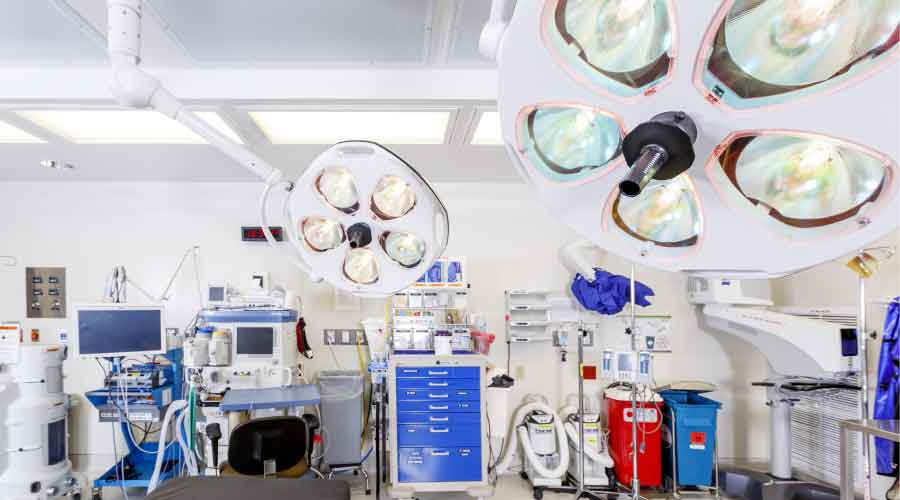Lighting Technology Helps Reduce Hospital Infection Rates
Tennessee medical center’s operating rooms benefit from disinfection technology.
By Jake Meister, Contributing Writer
When it comes to healthcare facilities, taking initiative has long been important — after all, preventing infections sounds a lot more positive than extinguishing an outbreak. Yet, staffing constraints and simple oversight have often led healthcare facilities to inadvertently stray away from the optimal amount of infection prevention, sometimes allowing a breakout to occur. That can no longer be the case.
Since the COVID-19 pandemic began to ravage the world in early 2020, Americans have developed a greater appreciation for facilities and operations taking significant measures to ensure impeccable cleanliness and disinfection for the benefit of public health. Conversely, their unease with places that fail to take cleanliness and infection prevention seriously has perhaps never been higher. That’s one reason why most facility managers in healthcare are exploring anything that gives them an edge in preventing healthcare-associated infections (HAIs). For proof of one successful plan, look no further than the Southeastern United States.
Trust the process
As a flagship medical facility serving more than 250,000 people in south central Tennessee, Maury Regional Medical Center (MRMC) has long felt a responsibility to operate at a pristine standard. That’s why it set the goal of reducing the incidence of HAIs at MRMC to zero.
Zero HAIs at a healthcare facility is the gold standard, accomplished only by the facilities that seriously set the goal in the first place. It requires preparation and quality work done with great consistency — every patient, every time. Recognizing this, MRMC put itself in a better position to succeed by implementing a two-step process.
The first step in the process involved a bundle of known evidence-based practices for reducing surgical site infections (SSIs). According to a 2019 article in the “American Journal of Infection Control,” MRMC’s SSI bundle involves, among other things, methicillin-resistant Staphylococcus aureus screening and decolonization of positive patients, chlorhexidine preparation at home, appropriate preoperative skin prep of patients, the proper use of facility-washed surgical attire, an emphasis on restricted operating room door opening, and educating caregivers on how to change the patient’s dressing in a sterile way as they recover from the procedure.
Once the practices were put into place, the next step to address was the quality of air in the operating room (OR). Specifically, the presence of organisms that can travel on air currents.
“There has been research published about how walking through a room can create a plume — you can’t see those,” says Lynnelle Murrell, director of infection prevention at Maury Regional Medical Center in Columbia, Tennessee. “The research involved air particle tracing, showing how particles can land on the sterile field or even in the open wound.”
Since research has proven microorganisms that come from skin cells shed in an operating room can travel via air currents, MRMC began researching light technology that would inactivate the microorganisms. That way, even if a microorganism traveling on skin cells landed somewhere it wasn’t supposed to, it would no longer have the capacity to cause harm.
After researching their options, the MRMC staff decided it would purchase luminaires with 405nm technology. Murrell says a top reason why MRMC selected those luminaires over others being considered is that Kenall’s product eliminated the need for human interaction, which of course comes with the risk of human error. As with most hospitals, staffing can be an issue, so forgoing a product that would put even more responsibility on staff was also a huge plus. The 405nm luminaires work continuously, which avoids any additional work on behalf of hospital staff.
Another important factor in hospital operations is to avoid delays in operating rooms.
“Having delays in surgery … at all costs you want to avoid that,” Murrell says. “Each minute that has a delay is costly.”
The plan within MRMC’s plan was to install the luminaires with 405nm technology into one of the operating rooms commonly used for knee and hip procedures. The staff would evaluate the bacteria levels in the room for several weeks before the lights were installed in October of 2016, and then for several more weeks after they were put in place, according to the article in “American Journal of Infection Control.” After all evaluations were finished, the medical center found bacteria had been reduced by more than 80 percent in the days following installation of the lights when compared to the days leading up to the installation. Those findings become even more impressive when considering the room was being used more often while the disinfecting luminaires were in place.
“Naturally, once the surgeons understood the mechanism of the lights, the request was higher in OR2 (where the lights were),” Murrell says.
Satisfied with the initial findings, the medical center eventually installed the luminaries in additional operating rooms, allowing the supplemental protection the lighting provided to shine even more.
Continued success
It’s now been more than six years — and one global pandemic — since the luminaires with 405nm technology have been installed in operating rooms at the medical center, and things are going as well as one could hope.
Murrell feels confident that MRMC can live up to its lofty goals since the changes were made in 2016. Her confidence is justified with the medical center averaging well under one post-hip replacement infection a year since the light has been put in place. There hadn’t been a single infection after a hip replacement procedure at the center between early 2021 and when Murrell was interviewed in September. Before that, there hadn’t been one such infection since November of 2019.
“I think that’s putting us well on our way to zero infections for hips,” Murrell says.
While the medical center is impressed with how great an asset the luminaires have been in its fight against HAIs, staff has been pleasantly surprised by promising studies suggesting the lights might also be a help in fighting off other dangers. For example, a group of microbiologists wrote in their paper published in the September 2021 edition of “Scientific Reports” that lipid-enveloped respiratory pathogens like SARS-CoV-2 and influenza A appear susceptible to 405nm visible light.
“Our results support further exploration of the use of visible light technology for the application of continuous decontamination in occupied areas within hospitals and/or infectious disease laboratories, specifically for the inactivation of respiratory pathogens such as SARS-CoV-2 and influenza A,” the authors wrote.
“I think that there are many more opportunities for the light’s use when you consider that it has since been shown to kill SARS-COV-2 and (influenza A),” Murrell says.
Should further research prove that 405nm technology can incapacitate even more pathogens, the medical center will be grateful. However, the benefits staff and patients have received as a result of the medical center’s project are enough to prove the correct decision was made.
Jake Meister is a freelance writer based in Milwaukee, Wisconsin.
Related Topics:












